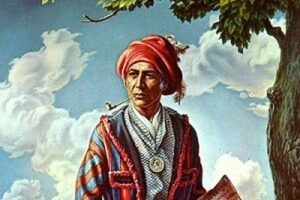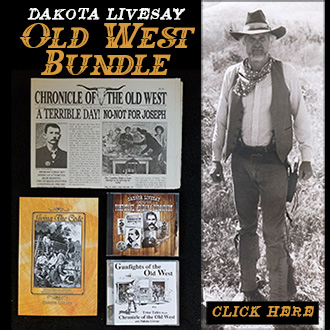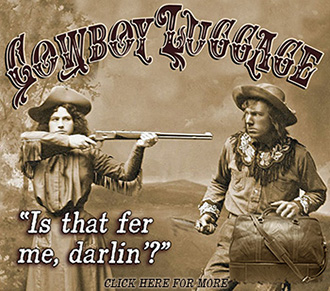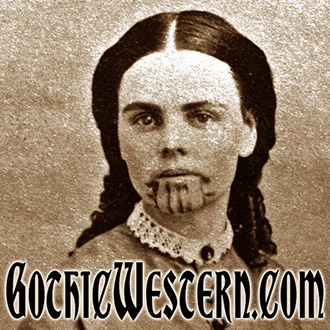Benjamin Singleton and the “Colored Exodus”
 It was early 1877. The Civil War had been over for more than ten years. But blacks still didn’t have the freedom they had hoped for. Tenant farming had replaced the plantation system. Because of the price of rented land, and supplies, the black farmer seldom broke even at the end of the year. So, they started looking for somewhere else that would give them true opportunity. Prior to the Civil War, by the vote of the residents, Kansas had changed from a slave to a free state. Although blacks had moved to Kansas on an individual basis, the first serious attempt to establish a black colony was on March 5, 1877 when Benjamin Singleton led a group from Tennessee to Baxter Springs located in the southeast corner of the state. Cherokee County Colony, Singleton Colony, Hill City, and Nicodemus Town followed. Most failed because of poor leadership, the transient nature of the emigrants, and having only marginal land available for settling.
It was early 1877. The Civil War had been over for more than ten years. But blacks still didn’t have the freedom they had hoped for. Tenant farming had replaced the plantation system. Because of the price of rented land, and supplies, the black farmer seldom broke even at the end of the year. So, they started looking for somewhere else that would give them true opportunity. Prior to the Civil War, by the vote of the residents, Kansas had changed from a slave to a free state. Although blacks had moved to Kansas on an individual basis, the first serious attempt to establish a black colony was on March 5, 1877 when Benjamin Singleton led a group from Tennessee to Baxter Springs located in the southeast corner of the state. Cherokee County Colony, Singleton Colony, Hill City, and Nicodemus Town followed. Most failed because of poor leadership, the transient nature of the emigrants, and having only marginal land available for settling.
It’s estimated that between fifteen and twenty thousand blacks migrated to Kansas in just a two-month period. Realizing the loss of cheap labor, southern landowners tried to stop the migration with intimidation and attacks against those involved in the “Colored Exodus.”
The biggest obstacle for blacks was that they had little or no money when they started their trek to Kansas. Many had only the possessions they could carry on their backs. However, they were assisted with relief efforts along the route from churches and private citizens.
By 1879 word got back to the south that the Kansas immigrants were facing tremendous problems in establishing a new life, and almost as fast as it started, the Kansas immigration dropped off to a trickle, and stopped.
Old West Gamblers
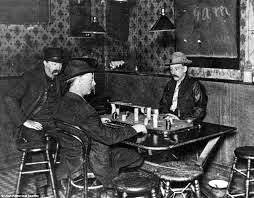 Old West gamblers who came out west wagered everything on the hopes of becoming prosperous and having a good life. That same spirit led them into gambling halls, and games of chance. One such game started on June 15, 1853 and ended 24 years later.
Old West gamblers who came out west wagered everything on the hopes of becoming prosperous and having a good life. That same spirit led them into gambling halls, and games of chance. One such game started on June 15, 1853 and ended 24 years later.
For people of the Old West gambling was a way of life. They risked their life by going into Indian Territory for furs, precious metal or land. They staked everything they owned on a herd of cattle being driven north. And for sure they enjoyed a game of chance.
There was faro, euchre, monte, casino, and, of course, poker…which, incidentally, was always dealt to the left of the player to make it easier to pull a gun with the right hand in case of irregularities. The origin of most games of chance came from Europe, with the exception of the old three walnuts and a pea, which started in America, probably on the streets of New York, where it still prospers.
Not only did cowboys loose their wages, but whole herds of cattle, and a cattleman’s entire wealth would change hands over night. A few wives were even offered to “match the pot.”
On June 15, 1853, in Austin, Texas Major Danelson and Mr. Morgan sat down to play poker, and evidentially with little to go home to, forgot to quit. The game went on for a week… then a month… a year became years. The Civil War broke out, was fought and lost, but these two Texas gentlemen still dealt the cards. Finally in 1872, 19 years after it started, both men died on the same day…but the game continued. Their two sons took over, and played for 5 more years.
Finally the game ended in 1877 when a railroad train killed one of the sons, and the other went crazy. Not that all these Old West gamblers weren’t crazy in the first place.
Tombstone Stage Held Up
On March 15, 1881 the Tombstone stage was held up. Although not intended as such, it ended up being one of the causes for the O. K. Corral shootout. On the other hand, the two objectives of the hold-up were not accomplished.
The main objective was the assassination of Wells Fargo shotgun guard, Bob Paul. As a Wells Fargo guard, Bob Paul had hampered the activities of the cowboys. And, the word around town was that he was to become the Pima County Sheriff. So the cowboys wanted to get rid of him. The assassination failed because when the stage departed Tombstone, stage driver Budd Philpot had gotten stomach pains and Budd exchanged positions with Paul. Orders were to kill the guard…which they did, but it was Philpot instead of Paul.
Paul was also responsible for the robbers not accomplishing their second objective…the theft of $26,000 in silver. When Philpot was shot, Bob grabbed his shotgun and fired off both barrels. One robber was killed and the noise of the shotgun spooked the horses. As the stagecoach was careening out of control, Paul climbed down; secured the reigns of the runaway steeds; and brought the stage safely into Benson.
Later, when he did became the Pima County Sheriff this 6’ 6”, 240-pound mountain of a man, typically using a shotgun, brought in bad guys, stopped lynchings, and hanged many a man legally. It always seemed that he was able to dodge that fatal bullet…That is until 1893 when he couldn’t dodge the one called cancer, and he died on March 26, 1901.
Sequoyah
Sequohah, born in 1760 in Tennessee, grew up among his mother’s people, the Cherokee. He became a metal craftsman, making beautiful silver jewelry. As a young man he joined the Cherokee volunteers who joined Andrew Jackson in the War of 1812. While with the American soldiers, he became intrigued with what he called “talking leaves,” or words on paper that somehow recorded human speech. Although Sequohah had no formal education, he somehow comprehended the basic nature of the symbolic representation of sounds.
In 1809 he began working on a Cherokee language. At first he tried picture symbols, but soon found them to be impractical. Then he started looking at English, Greek and Hebrew. He finally developed 86 characters that would express the various sounds in the Cherokee language. It was so simple in its concept that it could be mastered in less than a week.
In 1821 he submitted his new written language to the Cherokee leaders. As a demonstration Sequohah wrote a message to his six-year-old daughter. She read the message and responded in kind. The tribal council immediately adopted the system. And Cherokee of all ages started learning the written language.
The Cherokee were divided into two groups, Sequohah’s in Georgia and Tennessee, and the western Cherokee in Oklahoma. In 1822 Sequohah went to Oklahoma, and taught the alphabet to the Cherokee there.
Finally, on February 21, 1828 the first printing press with Cherokee type arrived in Georgia. Within months, the first Indian language newspaper appeared. It was called the Cherokee Phoenix.
Sequohah later went to Mexico to teach Cherokee there the language. While in Mexico he became ill with dysentery, and died. Great monuments to the man who developed the Cherokee alphabet stand today along the northern California coast. They are the giant redwood trees called the Sequoia.
Pearl Hart and the Wild Old West
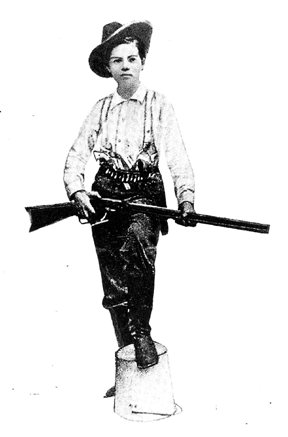 Just when everyone thought the wild Old West was gone, in 1899 a small slight woman by the name of Pearl Hart and her boyfriend held up a stagecoach in the Florence, Arizona area.
Just when everyone thought the wild Old West was gone, in 1899 a small slight woman by the name of Pearl Hart and her boyfriend held up a stagecoach in the Florence, Arizona area.
Their take was a little over $400. But they weren’t able to spend it, because in a short time they were captured and jailed.
Shortly afterward, with the help of some men, Pearl escaped. But, because of her fame, she was recognized and returned to jail.
Pearl and her boyfriend were tried and convicted. The boyfriend got 30 years and Pearl got 5.
Pearl’s life after she got out of jail is surrounded in myth. Some say she became “The Arizona Bandit” with Buffalo Bill and in vaudeville. Others say she married a Calvin Bywater and settled down to a life of domestic bliss.
Whichever one it was, Pearl never got crosswise with the law again.
Antonio Lopez de Santa Anna Dies
 In 1876 Antonio Lopez de Santa Anna died. I know of no other Old West character whose life was more of a roller coaster.
In 1876 Antonio Lopez de Santa Anna died. I know of no other Old West character whose life was more of a roller coaster.
Born to middle-class parents in Mexico, as a teenager he joined the army. In 1821 he gained national prominence as a military leader in Mexico’s fight for independence against Spain.
This resulted in his being elected the President of Mexico in 1833. And just two years later he proclaimed himself the dictator of Mexico.
During this time the Anglos in the area that is now Texas were agitating for independence.
Determined not to let this happen, Santa Anna took command of the army and invaded Texas. As we all know Santa
Anna was captured and Texas became an independent republic.
While he was a captive of Texas, he was deposed. Eleven times over the next two decades, Santa Anna regained and lost his dictatorship. The last time was in 1855.
The once mighty Antonio Lopez de Santa Anna died embittered and impoverished.
William Quantrill Dies
 On June 6, 1865 William Quantrill dies of wounds encountered in a skirmish with Union Soldiers.
On June 6, 1865 William Quantrill dies of wounds encountered in a skirmish with Union Soldiers.
At one time I referred to Quantrill as a man without any redeeming qualities. I was promptly told not to go into the Deep South and say that. I may not return under my own steam.
William Quantrill was Frank and Jesse James’ mentor. He was born in Ohio and after getting into trouble in Utah and Kansas he fled to Missouri where he became a strong supporter of slavery, even getting into violent conflicts with neighbors.
When the Civil War broke out…It’s also referred to by some as “the war of Northern aggression”…he formed a group of gorilla irregulars. As indicated earlier, Frank and Jesse James were members of Quantrill’s Raiders.
Quantrill not only attacked Union forces, he would attack unguarded pro-Union towns; most notably Lawrence, Kansas where the raiders shot every man and boy they could find. After killing 150 civilians, they left the town ablaze.
Incidentally, since Quantrill’s guerillas weren’t considered legitimate soldiers, they were never given amnesty after the conclusion of the war.
Republic of California
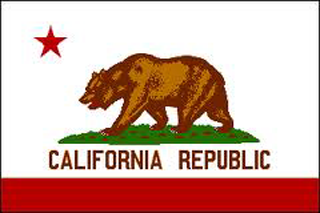 We all know that Texas was an independent republic before becoming a state. But did you know that California was an independent republic too? Here’s more about the Republic of California.
We all know that Texas was an independent republic before becoming a state. But did you know that California was an independent republic too? Here’s more about the Republic of California.
Although owned by Mexico, back in 1846 there were very few Mexican settlers in California. In reality there American settlers comprised the largest segment of the population.
On June 14, 1846, anticipating a war with Mexico, 33 Americans lead by William Ide invaded the Mexican outpost of Sonoma, north of San Francisco. They surrounded the home of Mexican General, Mariano Vallejo. With a bloodless victory, the Americans took a cotton sheet and with red paint they made a flag of a grizzly bear and single red star…A reference to the Texas Republic…and printed the words on the flag “California Republic”. The revolt was known as the Bear Flag Revolt.
Three weeks after California became an independent republic; American forces took control of Monterey and officially raised the American flag over California. Since this was what the American rebels wanted, they dissolved their government.
Incidentally, that Bear Flag became the official flag of California.
Warren Earp – Bringing a Knife to a Gunfight
 We’ve all heard about bringing a knife to a gunfight. Well, on this date back in 1900 that’s just what James, Morgan, Virgil and Wyatt’s little brother did.
We’ve all heard about bringing a knife to a gunfight. Well, on this date back in 1900 that’s just what James, Morgan, Virgil and Wyatt’s little brother did.
After participating in Wyatt’s ride of vengeance because of the cowboy’s wounding of Virgil and killing Morgan, Warren went to live with his parents in Colton, California.
With Warren regularly getting into trouble, his father got fed up with him and sent him packing. Warren ended up in Willcox, Arizona where he did a little cowboying and a lot of drinking. On July 6, 1900, Warren got crossways with a John Boyet. Some say it was because of a woman, others say it was a carry-over from the Tombstone days. In a confrontation, Warren kept pushing Boyet, until Boyet finally pulled his gun and killed Warren. This was a case of bringing a knife to a gunfight. For, it was discovered that Warren didn’t have a gun. But he did have a knife.
It seems that, to his dying day, Warren was trying to live up to the reputation of his brothers Wyatt and Virgil by being able to buffalo a man, and disarm him.
Old West Myth and Fact: Five Cartridges?
Here’s another Old West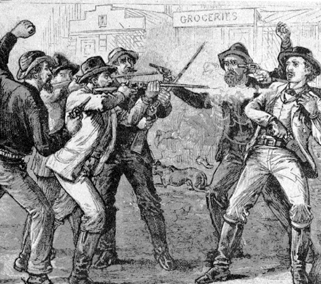 Myth and Fact. Tradition and the early Colt Pistol manuals says to load only five cartridges in a pistol and leave the empty cylinder under the hammer. The reason being if the hammer is accidently hit with a live cartridge under it, it could go off…Incidentally; modern pistols have a safety bar to prevent accidental firing.
Myth and Fact. Tradition and the early Colt Pistol manuals says to load only five cartridges in a pistol and leave the empty cylinder under the hammer. The reason being if the hammer is accidently hit with a live cartridge under it, it could go off…Incidentally; modern pistols have a safety bar to prevent accidental firing.
So, did they load only five cartridges? Not always. Wyatt Earp’s pistol fell to the floor in a saloon and it went off. Lawman Dallas Stoudenmire was being interviewed by a newspaper reporter. During the interview Dallas showed his shooting skills. The reporter said all six shots hit the target. A couple of years ago we published an article in Chronicle of the Old West from 1898 where two men went into the back room of a saloon, and while there a pistol was fired. The people in the saloon though it was a gun fight. Actually, one of the men dropped their pistol.
My feeling is if you were an average Joe you probably loaded five cartridges, but if there was a chance of gunplay you wanted as much firepower as possible. And that extra cartridge could mean the difference between life and death.
Jesse Chisholm Died of Food Poisoning
 On March 4, 1868 Jesse Chisholm died of food poisoning.
On March 4, 1868 Jesse Chisholm died of food poisoning.
Even though the Chisholm Trail is known for its use during the cattle drive era, Jesse wasn’t a cattleman, but a frontier trader. He had a great knowledge of the southwest that was valuable in trailblazing.
Because he was a trader, Jesse Chisholm’s trail was a straight road with easy river crossings and few steep grades so lumbering heavy freight wagons would have no trouble traveling it.
He had originally used this trail to supply his various trading posts among the Native American tribes in Indian Territory, what is now western Oklahoma. He worked with Black Beaver, a Lenape guide, to develop the trail. Chisholm died before the peak period of the cattle drives from Texas to Kansas; but he was important to numerous events in Texas and Oklahoma history. He served as an interpreter for both the Republic of Texas and the United States government in treaty-making with Native American tribes.
A year before Chisholm died; his trail also began to be used for cattle drives. For five years, more than a million head of cattle traveled up the road, creating a path that was 200 to 400 yards wide. Traces of the trail can still be seen to this day.
End of Kansas Trail Drives
 When it came to the Kansas Trail Drives, it seems that Kansas had a love-hate relationship with Texas cattle and the cowboys that brought them up.
When it came to the Kansas Trail Drives, it seems that Kansas had a love-hate relationship with Texas cattle and the cowboys that brought them up.
The love part was the profits to be made providing supplies to the cattle drives and a good time to trail-weary cowboys. Frontier struggling towns like Dodge City, Caldwell, Ellsworth, Hays, and Newton competed with Abilene to be the top “Cow Town” of Kansas.
But, as Kansas started getting less “frontier” and farming became more important, residents, anxious to attract businesses other than saloons and places of ill repute, started getting less enamored with the Texas cattle industry.
Although the Texas cattlemen tried to stay away from cultivated farmland, according to one cowboy “there was scarcely a day when we didn’t have a row with some settler.”
In addition to this, the Texas cattle carried a tick fever and hoof-and-mouth disease for which they were immune, but the Kansas cattle weren’t.
So, on this date back in 1885 the Kansas Legislature passed a bill that barred Texas cattle from the state between March and December 1.
This, along with the closing of open range with barbed wire fences, signaled an end to the cattle drives to Kansas.
The Prospector and the Gunfighter
Here’s the story of the Prospector and the Gunfighter, with not one, but five lessons for each of us:
An old prospector shuffled into town leading a tired old mule. The old man headed straight for the only saloon to clear his parched throat.
He walked up and tied his old mule to the hitch rail. As he stood there, brushing some of the dust from his face and clothes, a young gunslinger stepped out of the saloon with a gun in one hand and a bottle of whiskey in the other.
The young gunslinger looked at the old man and laughed, saying, “Hey old man, have you ever danced?”
The old man looked up at the gunslinger and said, “No, I never did dance. Never really wanted to.”
A crowd had gathered as the gunslinger grinned and said, “Well, you old fool, you’re gonna dance now,” and started shooting at the old man’s feet.
The old prospector — not wanting to get a toe blown off — started hopping around like a flea on a hot skillet. Everybody was laughing, fit to be tied.
When his last bullet had been fired, the young gunslinger, still laughing, holstered his gun and turned around to go back into the saloon.
The old man turned to his pack mule, pulled out a double-barreled shotgun, and cocked both hammers.
The loud clicks carried clearly through the desert air. The crowd stopped laughing immediately.
The young gunslinger heard the sounds too, and he turned around very slowly. The silence was almost deafening.
The crowd watched as the young gunman stared at the old timer and the large gaping holes of those twin barrels.
The barrels of the shotgun never wavered in the old man’s hands, as he quietly said, “Son, have you ever kissed a mule’s ass?”
The gunslinger swallowed hard and said, “No sir. But — I’ve always wanted to.”
There are a few lessons for us all here:
1 – Never be arrogant.
2 – Don’t waste ammunition.
3 – Whiskey makes you think you’re smarter than you are.
4 – Always, always make sure you know who has the power.
5 – Don’t mess with old men; they didn’t get old by being stupid.
Pearl Grey, Future Old West Author
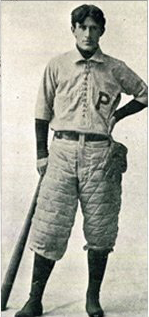 Today’s story is about a man who was a dentist. But he gave up his career to go out west and gain fame in a completely different profession. Do you think you know the person I’m talking about? You may be surprised: Pearl Grey was born on January 31, 1872. He was a talented baseball player, and played for the University of Pennsylvania while getting a degree in dentistry. Pearl was scheduled to follow in his father’s footsteps as a dentist. Looking for some excitement, he played some semi-pro baseball. But that didn’t satisfy his need.
Today’s story is about a man who was a dentist. But he gave up his career to go out west and gain fame in a completely different profession. Do you think you know the person I’m talking about? You may be surprised: Pearl Grey was born on January 31, 1872. He was a talented baseball player, and played for the University of Pennsylvania while getting a degree in dentistry. Pearl was scheduled to follow in his father’s footsteps as a dentist. Looking for some excitement, he played some semi-pro baseball. But that didn’t satisfy his need.
Incidentally, Pearl Grey never liked his first name, which was thought by everyone to be a woman’s name. So he decided to change it to his mother’s maiden name, Zane.
Pearl Zane Grey (January 31, 1872 – October 23, 1939) was an American author and dentist best known for his popular adventure novels and stories associated with the Western genre in literature and the arts; he idealized the American frontier. Riders of the Purple Sage (1912) was his best-selling book.
In addition to the commercial success of his printed works, his books have had second lives and continuing influence when adapted as films and television productions. His novels and short stories have been adapted into 112 films, two television episodes, and a television series, Dick Powell’s Zane Grey Theater.
A Duel With The Cactus
September 2, 1892, Daily Herald, El Paso, Texas – “Halt! What’s that?” said our leader in a sharp whisper.
It was a clear moonlight night in the extreme southwest of Mexico.
I was visiting a friend who conducted a large ranch and hacienda there.
A local revolt had just been quelled in the neighborhood and a spirit of lawlessness still pervaded the atmosphere. Only the night before my friend had been fired upon and one of his storehouses robbed by a band of Indians some fifteen or twenty strong. Early in the morning four of us, under the leadership of our host, had set out upon the track of the robbers.
We were well mounted, and resting only a few hours at noon had followed hard after them in a fair field we could drive them into quarters like cows to a pen, but we had no mind to run into a trap in the dark with five against fifteen; hence caution.
“Halt! What’s that?” our leader had whispered. We had come to the edge of a dense woods, and across an open space, upon the brow of a low sand hill, clearly outlined in the moonlight against the sky, we had discovered a dozen or more half naked fellows, with their arms extended in every direction, engaged in some sort of a weird, fantastic dance.
We could not see their legs, for the tops of the trees beyond the hill rose waist high, making a black background, but their arms moved slowly to and fro and we could easily imagine their legs keeping company.
“Those are the thieves!” our host muttered. “I know them, even at night. You fellow just come to the edge of the wood, where they can see you without knowing how many there are of you, and I’ll have them down here in no time.”
He rode out alone to the foot of the hill.
It required no little courage, and we watched him with proportionate admiration.
The figures did not cease their dance or notice him. Suddenly, with his rifle at his shoulder, he called to them: “I have you there! If one of you moves I’ll shoot him dead!”
The wind had been blowing through the trees, so that we could not have heard their response, but fortunately at that moment it ceased, and in the deep silence which settled down upon the forest in such a momentary lull we waited for the result.
Every Indian suddenly ceased his dancing and stood like a statue outlined against the sky.
“Come down here now,” shouted our host. “Come quietly, too, for the first man who makes any trouble drops dead.”
We could hear a sound, as of a hurried consultation of some sort, going on upon the hill for a moment, but the wind sprung up again before we could distinguish a single voice, and to our utter astonishment the fellows actually began their solemn dance again.
“Come down or I’ll shoot!” roared our host, but they kept on dancing and he did shoot.
Then there was commotion enough. A wild cry, followed by a cloud of dust rose from the brow of the hill.
“Fire!” yelled our host, and we responded with a well aimed volley, while he whipped out his heavy revolver and gave them another peppering.
There was a perfect bedlam of screams from the hill, and the dust hid everything from the view. They were either coming down or running for their lives.
For us it was either fly or follow. We waited irresolutely for the word of our leader, when the dust settled and there stood the Indians, silently going on with their fantastic dance as though we were a hundred miles away.
With a fierce ejaculation our host put spurs to his horse and dashed up the hill. We followed, without command, to find him upon the summit, sitting on the ground beneath a line of gaunt and ghostlike prickly pears—the ungainly cactus of Mexico.
The extended along the brow of the hill, their naked, skeleton branches spreading out in every unaccountable way and swaying solemnly in the breeze.
Among the roots a multitude of burrows in the dry dust showed where the sand birds had been lying, half buried, and quietly sleeping; and it was their noisy yelp we heard when they were frightened away by our host’s duel with the cactus.e ungainly cactus of Mexico.
The extended along the brow of the hill, their naked, skeleton branches spreading out in every unaccountable way and swaying solemnly in the breeze.
Among the roots a multitude of burrows in the dry dust showed where the sand birds had been lying, half buried, and quietly sleeping; and it was their noisy yelp we heard when they were frightened away by our host’s duel with the cactus.
Indian Cures
 October 9, 1892, Call, San Francisco, California – In the depths of the forest, an Indian breaks his leg or arm, said Dr. Hingston is his address at the British Medical Association meeting at Nottingham. Splints of softest material are at once improvised. Straight branches are cut, of uniform length and thickness. These are lined with down-like moss or scrapings or shavings of wood or with fine leaves interlaid with leaves, if in summer; or with the curled-up leaves of the evergreen cedar or hemlock, in winter; and the whole is surrounded with withes of willow or osier or young birch. Occasionally it is the soft but sufficiently unyielding bark of the poplar or the bass wood. Sometimes when near the marshy margin of our lakes or rivers the wounded limb is afforded support with wild hay or reeds of uniform length and thickness. Thus is the genius of Indian cures.
October 9, 1892, Call, San Francisco, California – In the depths of the forest, an Indian breaks his leg or arm, said Dr. Hingston is his address at the British Medical Association meeting at Nottingham. Splints of softest material are at once improvised. Straight branches are cut, of uniform length and thickness. These are lined with down-like moss or scrapings or shavings of wood or with fine leaves interlaid with leaves, if in summer; or with the curled-up leaves of the evergreen cedar or hemlock, in winter; and the whole is surrounded with withes of willow or osier or young birch. Occasionally it is the soft but sufficiently unyielding bark of the poplar or the bass wood. Sometimes when near the marshy margin of our lakes or rivers the wounded limb is afforded support with wild hay or reeds of uniform length and thickness. Thus is the genius of Indian cures.
To carry a patient to his wigwam or to an encampment a stretcher is quickly made of four young saplings, interwoven at their upper ends, and on this elastic, springy couch the injured man is borne away by his companions. When there are but two persons and an accident happens to one of them two young trees of birch or beech or hickory are used. Their tops are allowed to remain to aid in diminishing the jolting caused by the inequalities of the ground. No London carriage maker ever constructed a spring which could better accomplish the purpose. A couple of crossbars preserve the saplings in position, and the bark of the elm or birch cut into broad bands and joined to either side forms an even bed. In this way an injured man is brought by his companion to a settlement, and often it has been found on arrival that the fractured bones are firmly united and the limb is whole again. This is affected in less time than with the whites, for the recuperative power of these children of the forest is remarkable. In their plentitude of health osseous matter is poured out in large quantities and firm union is soon affected.
The reparative power of the aborigines when injured is equaled by the wonderful stoicism with which they bear injuries and inflect upon themselves the severest torture. They are accustomed to cut into abscesses with pointed flint; they light up a fire at a distance from the affected part (our counter-irritation; they amputate limbs with their hunting-knives, checking the hemorrhage with heated stones, as surgeons were accustomed to do in Europe in the time of Ambrose Pare, and sometimes they amputate their own limbs with more sang fiord than many young surgeons will display when operating on others. The stumps of limbs amputated in this primitive manner are well formed, for neatness is the characteristic of all Indians’ handiwork.
The Indians are familiar with and practice extensively the use of warm fomentations. In every tribe their old women are credited with the possession of knowledge of local bathing with hot water and of medicated decoctions. The herbs they use are known to a privileged few and enhance the consideration in which their possessors are held.
The Turkish bath, in a simpler but not less effective form, is well known to them. If one of their tribe suffers from fever or from the effects of long exposure to cold a steam bath is readily improvised. The tent of deerskin is tightly closed, the patient is placed in one corner, heated stones are placed near him, and on these water is poured until the confined air is saturated with vapor. Any degree of heat and any degree of moisture can be obtained in this way. Europeans often avail themselves of this powerful sudatory when suffering from rheumatism.
The Indians have their herbs—a few, not many. They have their emetics and laxatives, astringents and emollients, all of which are proffered to the suffering without fee or reward. The “Indian teas,” “Indian balsams” and other Indian cures —the virtues of which it sometimes takes columns of the daily journals to chronicle— belong to nature and are not theirs. To the white man is left this species of deception.
Some New Arithmetic
April 15, 1882, Mountain Democrat, Placerville, California – Some New Arithmetic:  In a schoolroom are twelve benches and nine boys on a bench. Find who stole the teacher’s gad.
In a schoolroom are twelve benches and nine boys on a bench. Find who stole the teacher’s gad.
A laundress takes in twelve shirts and has four stolen from her line. How many are left and what are the losers going to do about it.
A farmer sold eleven bushels of potatoes, with the product purchased two gallons of whisky at 90 cents per gallon. How much per bushel did he get for his tubers, and where did he keep the jug.
What velocity must a locomotive have to pick up a dead man walking on the track and fling him so high that six cars pass before he comes down?
A boy earned 20 cents a day for 18 days and bought his mother a muskrat muff costing $2.10. How much did he have left to go to the circus with?
A mother standing at the gate calls to her boy who is just 68 feet distant. It takes two minutes and twenty-two seconds for the sound to reach him. Find from this the velocity with which a woman’s voice travels.
A woman earned 42 cents a day by washing, and supported a husband who consumed $1 worth of provisions per week. How much was she in debt at the end of each month up to the time he was sent to the workhouse.
A father agreed to give his son four and a half acres of land for every cord of wood he chopped. The son chopped tree-sevenths of a cord and broke the ax and went off hunting rabbits. How much land was he entitled to?
A certain young man walks five-sevenths of a mile for seven nights in the week to see his girl, and after putting in 112 nights he gets the bounce. How many miles did he foot it altogether, and how many weeks did it take him to understand that he wasn’t wanted?
Two men agreed to build a wall together. One does four-fifths of the bossing and the other three-tenths of the work, and they finally conclude to pay a man $18 to finish the job. What is the length and height of the wall?
The Jersey Lily Mine
 March 31, 1897, Weekly Journal-Miner, Prescott, Arizona – In company with Gil S. Ferguson, a former owner of the Jersey Lily mine, the editor of the Journal Miner visited the above property this week, and was very courteously received and hospitably entertained by General Manager W. C. Bashford and Superintendent J. E. Clark. The underground workings were visited and examined—not in the capacity of an expert, but simply out of curiosity.
March 31, 1897, Weekly Journal-Miner, Prescott, Arizona – In company with Gil S. Ferguson, a former owner of the Jersey Lily mine, the editor of the Journal Miner visited the above property this week, and was very courteously received and hospitably entertained by General Manager W. C. Bashford and Superintendent J. E. Clark. The underground workings were visited and examined—not in the capacity of an expert, but simply out of curiosity.
The shaft is 370 feet deep. It is sunk on the ledge, which pitches at an angle of 44 degrees. The shaft is one of the best timbered ones in the county, everything being as neat and workman like as it is possible to make it. In addition to an old level, run at a depth of thirty feet, which is called the grass root level, but which is not now used, there are three levels run, one at each hundred feet of depth. At the 200 foot level, a south drift is in 250 feet and a north drift 180 feet. The latter is in good high grade ore all the way, while the former is also in ore, part of which is high grade and part of ore of lower grade, but good milling ore.
At the 300 foot level, the north drift is in 110 feet, with a solid body of ore all the way, averaging from three to four feet, and with a fine body of high grade ore on the face of the drift. The south drift is in 100 feet, but owing to the pitch of the ore chute on this side, the ore encountered in this is of lower grade, but improving now with every foot of work done. A small amount of stoping has been done, and the stopes also show up good ore bodies.
In the “grass root” level, a large body of rich honey comb ore, which made the Jersey Lily famous, even in the days of its infancy, remains exposed to view. It is very high grade, and a moderate fortune can be obtained from it at any time that it may be desired to take it out. Mr. Bashford has about twenty men at work at the present time, and on April 1st he will increase this force and will sink the shaft to a depth of over 500 feet, and will open up the 400 and 500 foot levels respectively.
The mine is equipped with one of the finest friction hoists in the territory. It is of sufficient capacity to sink to a depth of 1,000 feet or more.
The Lily Company also owns the Gold Treasure claim, a very promising one, which adjoins the Jersey Lily on the north, but on which very little development work has been done.
The company expects, during the summer, to erect a mill for the reduction of the ore. This will be done just as soon as the mine is opened up to a depth of 500 feet.
Northwest of the Jersey Lily, W. C. Bashford, J. E. Clark and Fred Smith own a claim, called Point Look Out, from which they have taken ore for shipment which went $250 per ton.
Another Killing For Dodge
April 20, 1886, Globe Live Stock Journal, Dodge, Kansas – On last Thursday evening at about six o’clock, a shooing took place on the south side of the railroad on the sidewalk in front of Utterback’s hardware store, two doors west of Ed Julian’s restaurant, the latter gentleman being the victim in the affray; and his antagonist, ex-assistant city marshal Ben Daniels.
Four shots were fired, all by Daniels, all of which took effect on Julian. While Julian was found to be armed, he however, did not get to fire a shot; there is much diversity of opinion in the matter, some claiming it to have been a deliberate murder, while others assert it to have been justifiable. The evidence taken at the preliminary trial does not fully sustain either. It was a well known fact that these parties had been bitter enemies to each other for a long time, and both had made threats against each other, which fact was not only elicited at the preliminary, but was know to many of our people long before the shooting took place. Ben Daniels, at the preliminary before Justice Harvey McGarry, was placed under a $10,000 bond for his appearance at the next term of court.
The remains of Ed. Julian were taken in charge by the member; of Lewis Post, G. A. R., of this place, who gave them a very respectable burial with appropriate ceremonies. This was a very unfortunate occurrence for this place, and that too at a time when everything appeared to be moving along so harmoniously and quietly. But it appears that no one could have prevented this tragedy, not even our officers, no matter how vigilant they might have been; the bitterness which existed between them was almost certain to bring them together sooner or later, and as many predicted, that one or the other or perhaps both would be mortally wounded, if not killed outright.
Artist Frederic Remington
 Although artist Frederic Remington had the look of an eastern lawyer or banker, on the inside he was a cowboy who could shoot and ride with the best.
Although artist Frederic Remington had the look of an eastern lawyer or banker, on the inside he was a cowboy who could shoot and ride with the best. Old West Book Review: The Devil’s Triangle
 The Devil’s Triangle, James Smallwood, Kenneth Howell, Carol Taylor, University of North Texas Press. Paper, $19.95. Non-fiction, Maps, Notes, Bibliography, Index.
The Devil’s Triangle, James Smallwood, Kenneth Howell, Carol Taylor, University of North Texas Press. Paper, $19.95. Non-fiction, Maps, Notes, Bibliography, Index.
This book is a well-written study of the War of Reconstruction in Texas between 1865 and 1877. Gangs of ex-Confederate soldiers returning home to Texas after the “Lost Cause“ harbored hatred and resentment toward freedmen (ex-slaves) and Northern sympathizers who tried to begin new lives after the Civil War.
For more than ten years, roving bands of robbers and highwaymen, acting under the guise of getting even for past grievances were determined to use the war as an excuse for the murder and mayhem they created. Most were really bandits and renegades using their hatred for a good excuse for their skullduggery.
One young ex-Confederate soldier, born and raised on a successful Texas farm, is featured in this book as one of the ringleaders operating throughout various Northeastern counties in Texas. Ben Bickerstaff came from a disciplined, hard-working family. He took to soldering at a young age, joined the Confederate Army when Texas went with the South and saw military action in a number of battles. He eventually became a prisoner of war and spent time in a Northern prison camp. A series of harsh experiences drove his hatred for the North, and by the time he returned home in Texas at Warts end, he was a bitter, battle-hard soldier determined to get even with everybody.
Bickerstaff was one of the organizers of the Ku Klux Klan, and apart from robbing and looting, he took part in the murders of many freedmen trying to live in their own new world. With peace officers few and far between, Bickerstaff and his followers created nearly constant fear and unrest in the entire Northeastern corner of the state of Texas. Due to his familiarity with the countryside learned from his boyhood, Bickerstaff and his followers were able to hide in heavily wooded areas where lawmen and bounty hunters could never successfully follow.
The book goes into detailed political maneuvers among those trying to create a. safe environment for law-abiding citizens living both in towns as well as on ranches. The emotional turmoil spilling over after years of war continued to cause harsh feelings among the people, and some even privately took sides with Bickerstaff’s hatred for the North. Bickerstaff’s crimes were horrific; folks who sympathized with the North were in peril until Bickerstaff’s own death at the hands of an armed group of townsfolk who had finally had enough of him. Bickerstaff was a married man, and it sounds like his wife was as tough as he was. Upon learning of his death, she angrily retrieved the body for burial in a place of her choice, even though the corpse had been beheaded.
We read about influential people such as Sam Houston trying to establish peace and tranquility in Texas newly returned to the Union. The history of Texas Reconstruction between 1865 and 1877 is fascinating and sometimes shocking. The authors have presented a serious, hard-hitting view of a difficult time in Texas history that has been mostly forgotten today. This book belongs in your Old West library.
Editor’s Note: The reviewer Phyllis Morreale-de la Garza is the author of numerous published books about the Old West, including 9 Days At Dragoon Springs, published by Silk Label Books, P.O. Box 399, Unionville, New York 10988 www.silklabelbooks.com
*Courtesy of Chronicle of the Old West newspaper, for more click HERE.
Grand Duke Alexis
 In January of 1872, the Russian Grand Duke Alexis went on what was called a “millionaire hunt.”
In January of 1872, the Russian Grand Duke Alexis went on what was called a “millionaire hunt.”Cattle Industry Decimated
 By the mid 1880’s the cattle industry was going wild. Speculators were overstocking the grazing ranges of Montana, Wyoming and the Dakotas. And with several mild winters they were also saving money by not putting up feed for wintertime. The summer of 1886 was a dry one. By autumn the range was almost barren of grass… And then winter came early with record-breaking snow falls. January 9, 1887 was the worst day of the worst winter, with an inch of snow falling each hour for 16 hours. The temperature went as low as 63 degrees below zero. It ended up with the cattle industry decimated.
By the mid 1880’s the cattle industry was going wild. Speculators were overstocking the grazing ranges of Montana, Wyoming and the Dakotas. And with several mild winters they were also saving money by not putting up feed for wintertime. The summer of 1886 was a dry one. By autumn the range was almost barren of grass… And then winter came early with record-breaking snow falls. January 9, 1887 was the worst day of the worst winter, with an inch of snow falling each hour for 16 hours. The temperature went as low as 63 degrees below zero. It ended up with the cattle industry decimated.Train Robbed By Road Agents
 January 22, 1883, Bee, Sacramento, California – Passenger train No. 1, which left Sacramento Saturday night, was captured at Montello last night by masked road agents who relieved the train men of their watches and money and then locked them up in the tank. They then cut the engine, postal and express cars off and put them on the sidetrack, and called express messenger Ross, who, thinking he was at Tacoma, opened the car door.
January 22, 1883, Bee, Sacramento, California – Passenger train No. 1, which left Sacramento Saturday night, was captured at Montello last night by masked road agents who relieved the train men of their watches and money and then locked them up in the tank. They then cut the engine, postal and express cars off and put them on the sidetrack, and called express messenger Ross, who, thinking he was at Tacoma, opened the car door.
He was commanded to step out, but declined, and shutting the car door was fired upon and wounded in the hand. He kept the door closed and returned the fire as best he could. Some fifteen or twenty shots were exchanged, the door being badly battered up.
The section men were robbed and locked up just before No. 1 reached Montello. When No. 2 arrived at Montello, Conductor Clement was ordered to pull out, which he did, reaching Tacoma as soon as possible and reported train No. 1 as in the hands of robbers.
The train was released and reported at Tacoma before an armed force could be dispatched from Tacoma. The passengers were not molested and nothing was lost except the money taken from train employees. Their watches were returned.
The man who took charge of the engine is described as 5 feet 9 inches high, and of light complexion. Conductor Casson, who had charge of the train, thinks there were six men and nine horsed, while Clement thinks there were fifteen. They rode off in a southerly direction.
The Chinese section hands robbed were badly demoralized and will not work. Four of them walked to Tacoma and had their feet badly frozen.
The No. 2 was the westbound overland passenger train, which stopped at the place where the robbers were at work, and was ordered on and hurried to Tacoma, four miles away, to give the alarm. Had they got through with No.1 before No. 2 arrived it was doubtless intended to rob the latter also.
The robbery took place in Elko County, Nevada, 100 moles from Elko and 167 miles from Ogden. The train was due at the latter place at 8 A.M., but was about three hours late in consequence of the robbery.
The Central Pacific Railroad Company has offered a reward of $500 for each man arrested and convicted, in addition to the regular reward of Wells, Fargo and Co. All detectives and officers have been notified.



